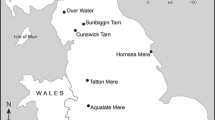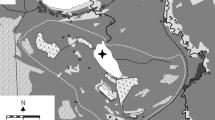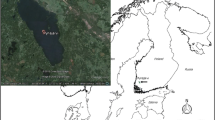Abstract
The roles of both landscape alteration and in-lake processes need to be considered in conservation strategies for shallow lakes in the prairie regions of North America. Here we focus on shallow lakes in west-central Minnesota, USA, highlighting the long-term ecological history and response to known landscape changes of a clear-water, macrophyte-dominated, shallow lake. Contemporary limnological data suggest the aquatic ecosystem has been very stable and fishless for the last ~15 years. Sediment proxies for primary production and ecological change confirm that a stable ecosystem likely prevailed for the last ~200 years. However, sedimentary indicators of catchment erosion detail a distinct response to land-use change during the conversion of native grassland to agricultural land, and following establishment of a protected waterfowl production area (WPA) around the lake. Post-WPA, the rate of sediment accrual decreased dramatically within 5–10 years and sources of organic matter were similar to those of the pre-settlement period. The aquatic ecosystem has been able to withstand nutrient enrichment and allochthonous inputs because stable trophic interactions have likely been in place for more than 200 years. We conclude that lack of hydrologic connectivity and isolated, small catchments are important factors in the promotion of clear-water shallow lake ecosystems, mainly because they prevent colonization by fish and associated ecological consequences. This study highlights the importance of managing both the landscape and in-lake processes to maintain stable, clear-water, shallow lakes.







Similar content being viewed by others
References
Appleby PG (2001) Chronostratigraphic techniques in recent sediments. In: Last WM, Smol JP (eds) Tracking environmental change using lake sediments. Basin analysis, coring, and chronological techniques. Kluwer, Dordrecht, pp 171–203
Appleby PG, Oldfield F (1978) The calculation of lead–210 dates assuming a constant rate of supply of unsupported 210Pb to the sediment. Catena 5:1–8
Arar EJ, Collins GB (1997) In vitro determination of chlorophyll a and pheophytin a in marine and freshwater algae by fluorescence. National exposure research laboratory, Office of research and development, US environmental protection agency, Cincinnati, Ohio
Battarbee RW, Jones VJ, Flower RJ, Cameron NG, Bennion H, Carvalho L, Juggins S (2001) Diatoms. In: Smol JP, Birks HJB, Last WM (eds) Tracking environmental change using lake sediments. Terrestrial, algal, and siliceous indicators, vol 3. Kluwer, Dordrecht, pp 155–202
Bayley S, Prather C (2003) Do wetland lakes exhibit alternative stable states? Submersed aquatic vegetation and chlorophyll in western boreal shallow lakes. Limnol Oceanogr 48:2335–2345
Belmont P, Gran KB, Schottler SP, Wilcock PR, Day SS, Jennings C, Lauer JW, Viparelli E, Willenbring JK, Engstrom DR, Parker G (2011) Large shift in source of fine sediment in the Upper Mississippi River. Environ Sci Technol 45:8804–8810
Bergström A (2010) The use of TN: TP and DIN: TP ratios as indicators for phytoplankton nutrient limitation in oligotrophic lakes affected by N deposition. Aquat Sci 72:277–281
Binford M (1990) Calculation and uncertainty analysis of Pb 210 dates for PIRLA project lake sediment cores. J Paleolimnol 3:253-267
Boës X, Rydberg J, Martinez-Cortizas A, Bindler R, Renberg I (2011) Evaluation of conservative lithogenic elements (Ti, Zr, Al, and Rb) to study anthropogenic element enrichments in lake sediments. J Paleolimnol 46:75–87
Bradshaw EG, Rasmussen P, Odgaard BV (2005) Mid- to late-Holocene land-use change and lake development at Dallund Sø, Denmark: synthesis of multiproxy data, linking land and lake. Holocene 15:1152–1162
Brenner M, Keenan LW, Miller SJ, Shelske C (1999) Spatial and temporal patterns of sediment and nutrient accumulation in shallow lakes of the Upper St. Johns River Basin, Florida. Wetl Ecol Manag 6:221–240
Carlson RE (1977) A trophic state index for lakes. Limnol Oceanogr 22:361–369
Conley DJ, Schelske CL (2001) Biogenic silica. In: Last WM, Smol JP (eds) Tracking environmental change using lake sediments. Terrestrial, algal, and siliceous indicators. Kluwer, Dordrecht, pp 281–294
Cooke C, Wolfe A, Hobbs W (2009) Lake-sediment geochemistry reveals 1,400 years of evolving extractive metallurgy at Cerro de Pasco, Peruvian Andes. Geol 37:1019–1022
Crumpton WG, Isenhart TM, Mitchell PD (1992) Nitrate and organic N analyses with second-derivative spectroscopy. Limnol Oceanogr 37:907–913
DeMaster DJ (1991) Measuring biogenic silica in marine sediments and suspended matter. In: Hurd DC, Spenser DW (eds) Marine particles: analysis and characterization. American Geophysical Union, Washington, pp 363–368
Depp ER, Lathrop RC (1992) A comparison of two rake sampling techniques for sampling aquatic macrophytes. Wis Dep Nat Resour Res Manage Find No. 32
Eaton A, Clescerl L, Rice EW, Greenberg A (eds) (1999) Standard methods for the examination of waters and wastewaters, 21st edn. American Public Health Association, Washington
Edwards GP, Molof AH, Schneeman RW (1965) Determination of orthophosphate in fresh and saline waters. J Am Water Works Assoc 57:917–925
EPA (1996) Test methods for evaluating solid waste, physical/chemical methods, method 3050b. http://www.epa.gov/osw/hazard/testmethods/sw846/pdfs/3050b.pdf
Euliss NH Jr, Gleason RA, Olness A, McDougal RL, Murkin HR, Robarts RD, Bourbonniere RA, Warner BG (2006) North American prairie wetlands are important non-forested land-based carbon storage sites. Sci Tot Environ 361:179–188
Fallu MA, Allaire N, Pienitz R (2000) Freshwater diatoms from northern Québec and Labrador (Canada): species-environment relationships in lakes of boreal forest, forest-tundra and tundra regions. Bibliotheca Diatomologica, vol 45. E. Schweizerbart, Germany, p 200
Gleason RA, Euliss NH Jr (1998) Sedimentation of prairie wetlands. Great Plains Res J Nat Soc Sci 8:97–112
Gleason RA, Euliss NH, Hubbard DE, Duffy WG (2003) Effects of sediment load on emergence of aquatic invertebrates and plants from wetland soil egg and seed banks. Wetlands 23:26–34
Grimm EC (1987) CONISS, a Fortran 77 program for stratigraphically constrained cluster analysis by the method of incremental sum of squares. Comput Geol 13:13–35
Hall R, Leavitt P, Quinlan R, Dixit A, Smol J (1999) Effects of agriculture, urbanization, and climate on water quality in the northern Great Plains. Limnol Oceanogr 44:739–756
Hanson M, Butler M (1994) Responses of plankton, turbidity, and macrophytes to biomanipulation in a shallow prairie lake. Can J Fish Aquat 51:1180–1188
Heiri O, Lotter AF, Lemcke G (2001) Loss on ignition as a method for estimating organic and carbonate content in sediments: reproducibility and comparability of results. J Paleolimnol 25:101–110
Herwig BR, Zimmer KD, Hanson MA, Konsti ML, Younk JA, Wright RA, Vaughn SA, Haustein MD (2010) Factors influencing fish distributions in shallow lakes in prairie and prairie-parkland regions of Minnesota, USA. Wetlands 30:609–619
Hieltjes A, Lijklema L (1980) Fractionation of inorganic phosphates in calcareous sediments. J Environ Qual 9:405
Hill MO, Gauch HG (1980) Detrended correspondence analysis—an improved ordination technique. Vegetatio 42:47–58
Hobbs W, Hobbs J, Lafrancois T, Zimmer K, Theissen K, Edlund M, Michelutti N, Butler M, Hanson M, Carlson T (2012) A 200-year perspective on alternative stable state theory and lake management from a biomanipulated shallow lake. Ecol Appl 22:1483–1496
Jackson DA (1993) Stopping rules in principal components analysis: a comparison of heuristical and statistical approaches. Ecology 74:2204–2214
Jeppesen E, Jensen J, Søndergaard M, Lauridsen T, Pedersen L, Jensen L (1997) Top-down control in freshwater lakes: the role of nutrient state, submerged macrophytes and water depth. Hydrobiol 342:151–164
Jeppesen E, Søndergaard M, Søndergaard M, Christoffersen K (1998) The structuring role of submerged macrophytes in lakes. Springer, New York, p 471
Jeppesen E, Peder Jensen J, Søndergaard M, Lauridsen T, Landkildehus F (2000) Trophic structure, species richness and biodiversity in Danish lakes: changes along a phosphorus gradient. Freshw Biol 45:201–218
Jeppesen E, Søndergaard M, Meerhoff M, Lauridsen TL, Jensen JP (2007) Shallow lake restoration by nutrient loading reduction—some recent findings and challenges ahead. Hydrobiol 584:239–252
Johnson WC, Millett BV, Gilmanov T, Voldseth RA, Guntenspergen GR, Naugle DE (2005) Vulnerability of Northern prairie wetlands to climate change. Bioscience 55:863–872
Keeling CD, Bacastow RB, Carter AF, Piper SC, Whorf TP, Heimann M, Mook WG, Roeloffzen H (1989) A three-dimensional model of atmospheric CO2 transport based on observed winds. In: Peterson DL (ed) Aspects of climate variability in the Pacific and western Americas. American Geophysical Union Geophys Monogr 55:165–236
Krammer K, Lange-Bertalot H (1986) Bacillariophyceae. 1. Teil: Naviculaceae. In: Ettl H, Gärtner G, Gerloff J, Heynig H, Mollenhauer D (eds) Süßwasserflora von Mitteleuropa. Band 2/1. Gustav Fischer, Stuttgart, p 876
Krammer K, Lange-Bertalot H (1988) Bacillariophyceae. 2. Teil: Bacillariaceae, Epithemiaceae, Surirellaceae. In: Ettl H, Gärtner G, Gerloff J, Heynig H, Mollenhauer D (eds) Süßwasserflora von Mitteleuropa, Band 2/2. Gustav Fischer, Stuttgart, p 596
Krammer K, Lange-Bertalot H (1991a) Bacillariophyceae. 3. Teil: Centrales, Fragilariaceae, Eunotiaceae. In: Ettl H, Gärtner G, Gerloff J, Heynig H, Mollenhauer D (eds) Süßwasserflora von Mitteleuropa, Band 2/3. Gustav Fischer, Stuttgart, p 576
Krammer K, Lange-Bertalot H (1991b) Bacillariophyceae. 4. Teil: Achnanthaceae Kritische Ergäzungen zu Navicula (Lineolatae) und Gomphonema. In: Ettl H, Gärtner G, Gerloff J, Heynig H, Mollenhauer D (eds) Süßwasserflora von Mitteleuropa, Band 2/4. Gustav Fischer, Stuttgart, p 437
Martin DB, Hartman WA (1987) The effect of cultivation on sediment composition and deposition in prairie pothole wetlands. Water Air Soil Poll 34:45–53
Mazumder A (1994) Patterns of algal biomass in dominant odd-versus even-link ecosystems. Ecology 75:1141–1149
Millett B, Johnson WC, Guntenspergen G (2009) Climate trends of the North American Prairie Pothole Region 1906–2000. Clim Change 93:243–267
Oslund FT, Johnson RR, Hertel DR (2010) Assessing wetland changes in the Prairie Pothole Region of Minnesota from 1980 to 2007. J Fish Wildlife Manag 1:132–135
Potthoff AJ, Herwig BR, Hanson MA, Zimmer KD, Butler MG, Reed JR, Parsons BG, Ward MC (2008) Cascading food-web effects of piscivore introductions in shallow lakes. J Appl Ecol 45:1170–1179
R Core Development Team (2001) R: a language and environment for statistical computing. R Foundation for Statistical Computing, Vienna, Austria. http://www.R-project.org
Ramstack JM, Fritz SC, Engstrom DR (2004) Twentieth century water quality trends in Minnesota lakes compared with presettlement variability. Can J Fish Aquat Sci 61:561–576
Reavie ED, Smol JP (1998) Freshwater diatoms of the St. Lawrence River, Bibliotheca Diatomologica 41. J. Cramer, University of California, p 137
Sayer CD, Davidson TA, Jones JI, Langdon PG (2010a) Combining contemporary ecology and palaeolimnology to understand shallow lake ecosystem change. Freshw Biol 55:487–499
Sayer CD, Davidson TA, Jones JI (2010b) Seasonal dynamics of macrophytes and phytoplankton in shallow lakes: a eutrophication-driven pathway from plants to plankton? Freshw Biol 55:500–513
Scheffer M, Hosper S, Meijer M, Moss B (1993) Alternative equilibria in shallow lakes. TREE 8:275–279
Scheffer M, Van Geest GJ, Zimmer KD, Jeppesen E, Butler MG, Hanson MA, Søndergaard M, Declerck S, De Meester L (2006) Small habitat size and isolation can promote species richness: second-order effects on biodiversity in shallow lakes and ponds. Oikos 112:227–231
Schelske CL, Hodell DA (1995) Using carbon isotopes of bulk sedimentary organic matter to reconstruct the history of nutrient loading and eutrophication in Lake Erie. Limnol Oceanogr 40:918–929
Skagen SK, Melcher CP, Haukos DA (2008) Reducing sedimentation of depressional wetlands in agricultural landscapes. Wetlands 28:594–604
Swanson GA (1978) A plankton sampling device for shallow wetlands. J Wildlife Manag 42:670–672
Theissen KM, Hobbs WO, Hobbs JMR, Zimmer KD, Domine LM, Cotner JB, Sugita S (2012) The altered ecology of Lake Christina: a record of regime shifts, land-use change, and management from a temperate shallow lake. Sci Tot Environ 433:336–346
Van Geest GJ, Roozen FCJM, Coops H, Roijackers RMM, Buijse AD, Peeters ETHM, Scheffer M (2003) Vegetation abundance in lowland floodplain lakes determined by surface area, age and connectivity. Freshw Biol 48:440–454
Verardo DJ, Froelich PN, McIntyre A (1990) Determination of organic carbon and nitrogen in marine sediments using the Carlo Erba NA-1500 analyzer. Deep Sea Res 37:157–165
Vermaire J, Gregory-Eaves I (2008) Reconstructing changes in macrophyte cover in lakes across the northeastern United States based on sedimentary diatom assemblages. J Paleolimnol 39:477–490
Wright HE (1991) Coring tips. J Paleolimnol 6:37–49
Zimmer KD, Hanson MA, Butler MG (2001) Effects of fathead minnow colonization and removal on a prairie wetland ecosystem. Ecosystems 4:346–357
Zimmer KD, Hanson MA, Butler MG (2002) Effects of fathead minnows and restoration on prairie wetland ecosystems. Freshw Biol 47:2071–2086
Zimmer K, Hanson M, Butler M (2003) Relationships among nutrients, phytoplankton, macrophytes, and fish in prairie wetlands. Can J Fish Aquat Sci 60:721–730
Zimmer KD, Herwig BH, Laurich LM (2006) Nutrient excretion by fish in wetland ecosystems and its potential to support algal production. Limnol Oceanogr 51:197–207
Zimmer KD, Hanson MA, Herwig BR, Konsti ML (2009) Thresholds and stability of alternative regimes in shallow prairie-parkland lakes of Central North America. Ecosystems 12:843–852
Acknowledgments
We thank Mark Edlund for field assistance and Elizabeth Droessler and Alaina Fedie for laboratory assistance. Dan Engstrom and Shawn Schottler provided thoughtful comments and established the geochronology. Personal communications with the US Fish and Wildlife Service about the history of the Blakesley Lake WPA were important to this article. This article benefited from the comments and thoughts of Mark Brenner, Jim Cotner, and two anonymous reviewers. Funding was provided by the National Science Foundation (DEB-0919095, DEB-0919070, and DEB- 0918753) and the University of St. Thomas.
Author information
Authors and Affiliations
Corresponding author
Rights and permissions
About this article
Cite this article
Hobbs, W.O., Theissen, K.M., Hagen, S.M. et al. Persistence of clear-water, shallow-lake ecosystems: the role of protected areas and stable aquatic food webs. J Paleolimnol 51, 405–420 (2014). https://doi.org/10.1007/s10933-013-9763-1
Received:
Accepted:
Published:
Issue Date:
DOI: https://doi.org/10.1007/s10933-013-9763-1




